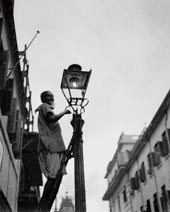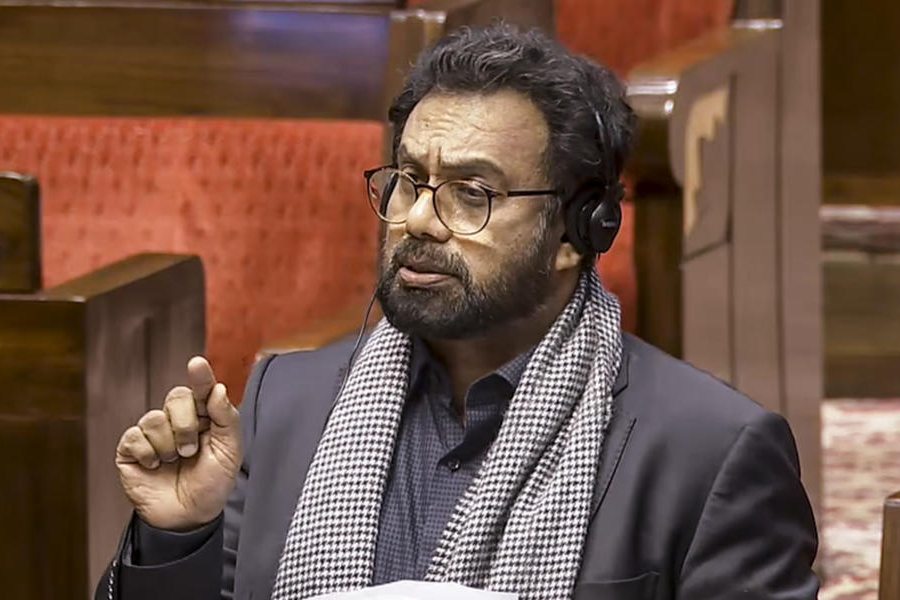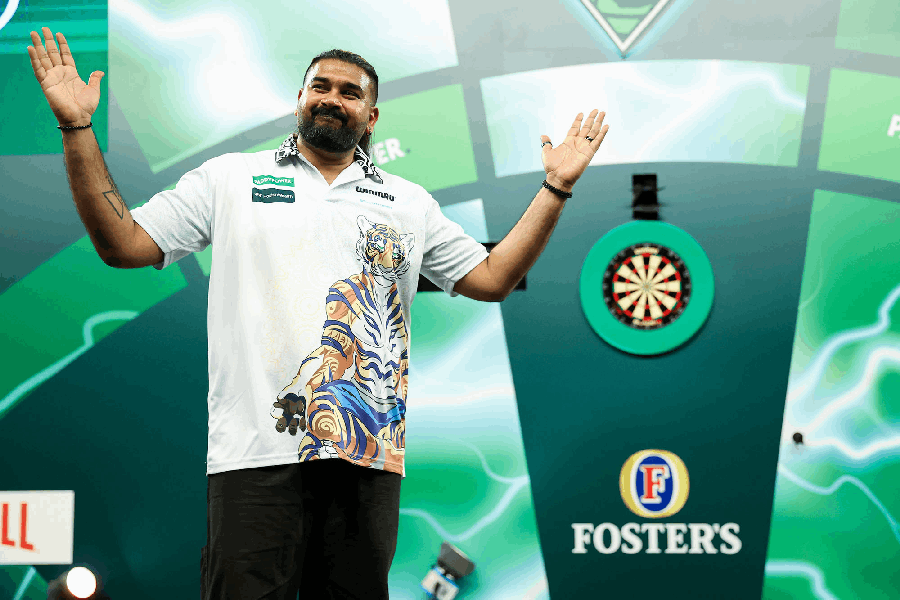 |
| A 1962 picture of a man lighting a gas lamp in Calcutta, from the exhibition at Gaganendra Pradarshashala |
 |
| Dibyendu Palit releases the book with Nirendranath Chakraborty by his side on Monday. Picture by Sudeshna Banerjee |
Two eminent citizens have recently brought back Calcutta’s past to the present. One of them was litterateur and cartoonist Himanish Goswami, who was a photographer as well and had clicked thousands of pictures of Calcutta and London in the 1950s and earlier. He recently held an exhibition of his black and white photographs at Gaganendra Pradarshashala.
The portraits of Parimal Goswami, Shakti Chatterjee, Shailajananda Mukhopadhyay, Shibram Chakrabarty (on the balcony of his mess) and Ramapada Chowdhury by Goswami, who was born in March, 1926, are quite remarkable. London is all-white and there are hardly any people around. The juxtaposition of processions, soapbox orators and men taking a siesta in London and Calcutta bring out the humour of such situations.
The other citizen is the city’s “barefoot” historian, P.T. Nair, Bengali translations of some of whose articles were published in various newspapers, have been compiled in a book titled, Kalkattanama: Bishoy: Kolkata, brought out by Sadesh. The various chapters are about city history, origins of its name, Job Charnock, revolutionaries, the Oriyas of Calcutta, a celebration of Calcutta theatre and south Indians of the city.
Two photographs stand out: a man lighting a gas lamp in 1962 and another shows the grounds opposite Writers’ Buildings where Dalhousie Institute stood. Telephone Bhavan came up there years later.
For the love of words
Few cine-goers would connect an author who lost a government job in 1940 for seditious writing with a film-maker who won a National Award in 1988. But Nabendu Ghosh wore both hats.
The author of Daak Diye Jai, Aajab Nagarer Kahini, Chaand Dekhechilo, Bichitra Ek Prem Gatha was also the screenplay-writer of Devdas, Sujata, Bandini, Teesri Kasam, Abhimaan and Trishagni (also director).
On March 17, 10 days before he was to turn 90, his autobiography Eka Naukar Jatri was launched by Dey’s Publishing. He was no more but his friends and admirers gathered to remember the man who never put his pen down despite shifting to Bombay in 1950 and teaming up with the likes of Bimal Roy. All contemporary events touched his sensitivities as author — be it the Quit India movement or the riots in Calcutta or the plights of industrialisation and water scarcity in Mumbai, recalled daughter Ratnottama Sengupta.
“I knew him from his Pataldanga Street days, just after the 1946 riots,” said poet Nirendranath Chakraborty of a friend seven years older to him. “We landed at his place when we had no money for tea. After he left town, whoever went to Mumbai would put up at his place in Pushpa Colony, Malad.”
Feted Ghosh may be for his work in films, but Chakraborty, now the chairman of Bangla Akademi, pointed out that his friend believed that the frame of literature was bigger than that of films. “It must have pained him no end to quit literature and switch profession. This love made him return to Calcutta and to writing at that advanced age.”
Author Dibyendu Palit spoke of his association with Ghosh starting with their meeting to commission Ghosh to write for a Bengali newspaper Palit worked for. “I inspired him to pen his memoirs rather than fiction since he had lived such a colourful life touched by towering personalities like Bimal Roy and Ashok Kumar. I insisted on the title Eka Noukar Jatri. That made it more dramatic. When he submitted the first instalment I knew it would be an asset to Bengali literature,” Palit said.
Listeners who were treated to readings of sections of the book could not have agreed more.
(Contributed by Soumitra Das and Sudeshna Banerjee)










